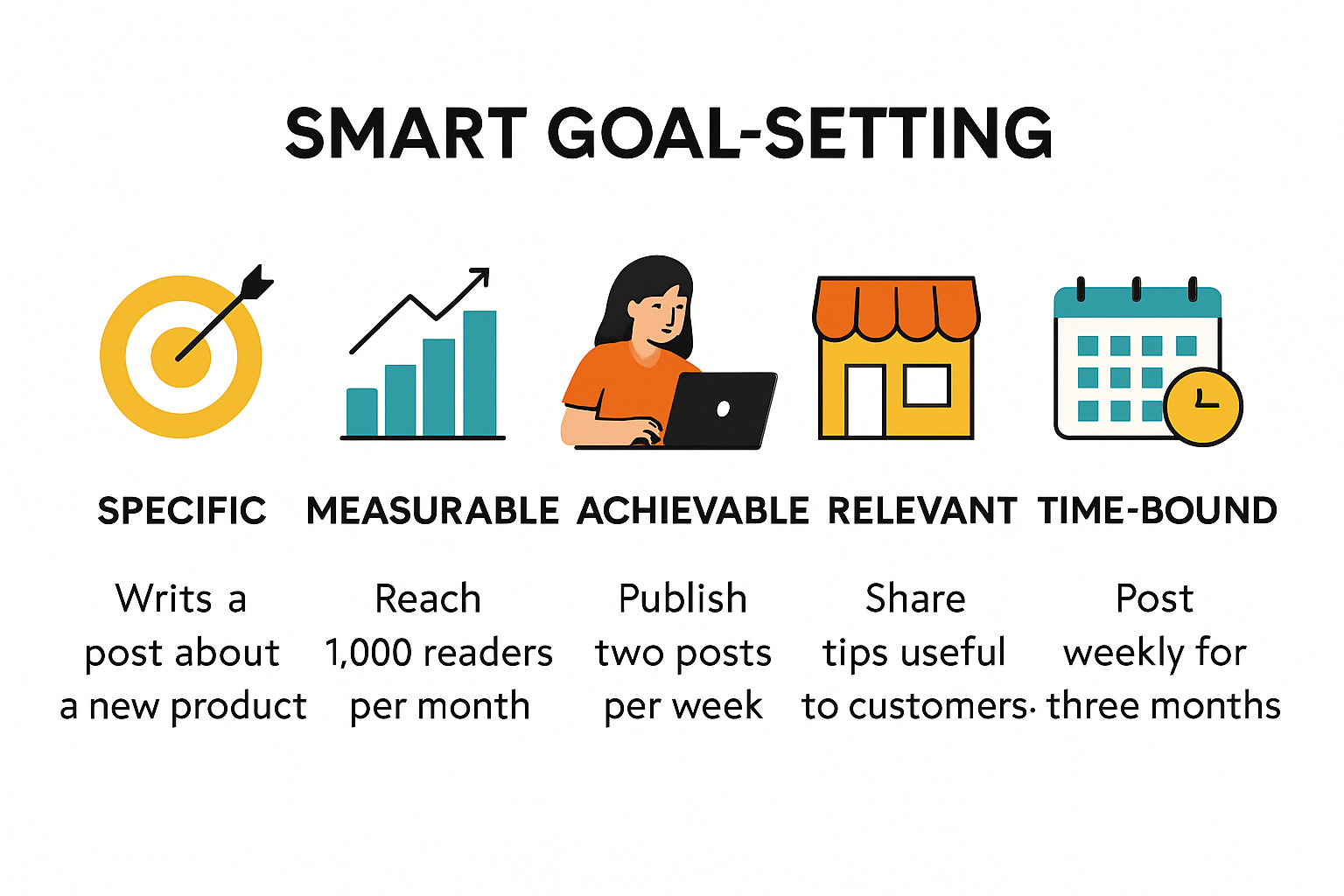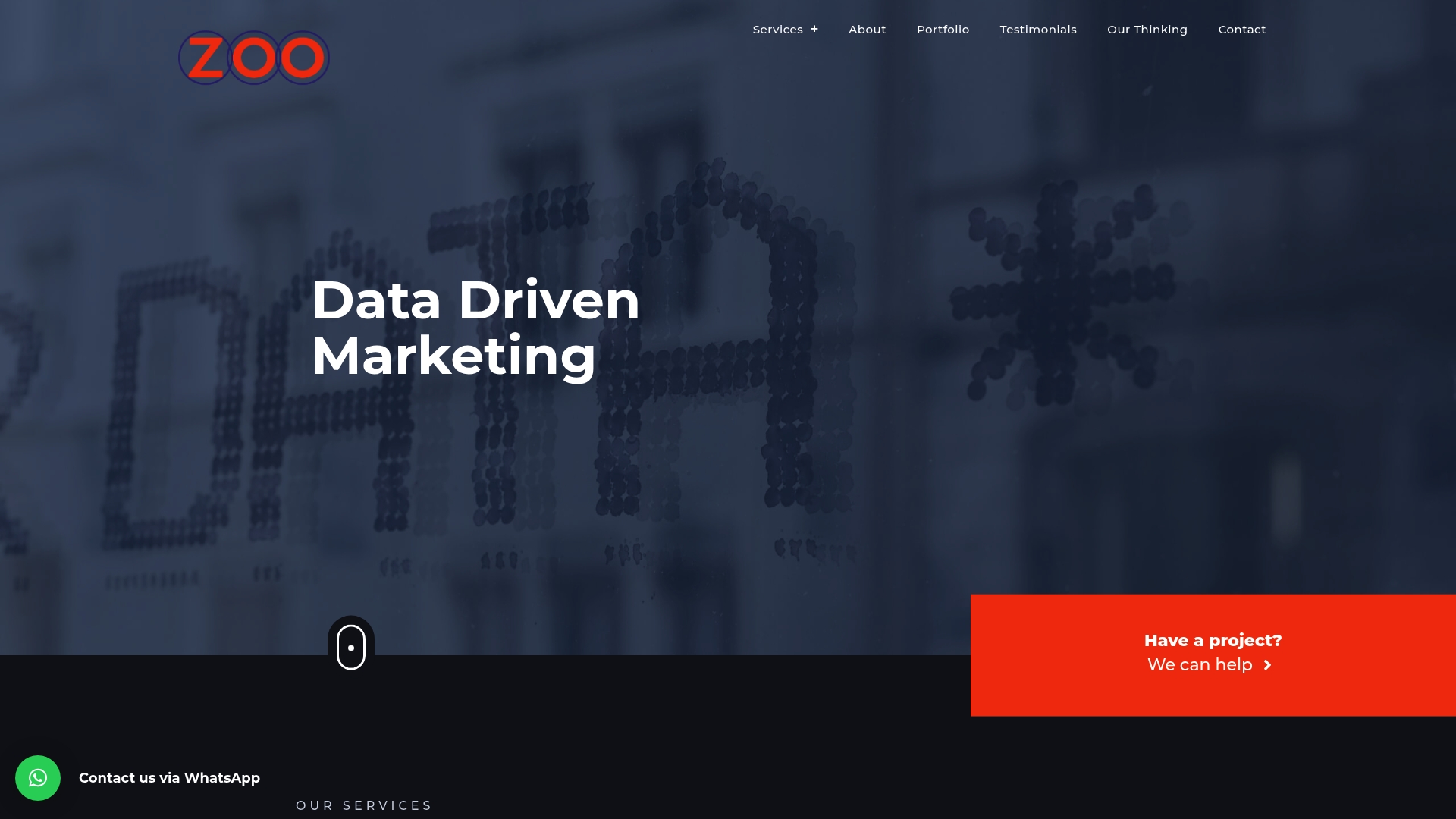Starting a small business blog sounds simple enough. Write what you know, post it online, and watch customers roll in, right? But only about 20 percent of small business blogs actually see consistent growth after launch. Most end up abandoned within a year. The secret is not just in writing but in building a blog around proper goals, strategy, and promotion from day one.
Table of Contents
- Step 1: Define Your Blogging Goals And Audience
- Step 2: Set Up Your Blog Platform And Domain
- Step 3: Create A Content Strategy And Editorial Calendar
- Step 4: Write Engaging And Seo-Enriched Blog Posts
- Step 5: Promote Your Blog Posts Across Channels
- Step 6: Analyze Performance And Adjust Your Strategy
Quick Summary
| Key Point | Explanation |
|---|---|
| 1. Define blogging goals clearly | Establish specific, measurable objectives to align content with business ambitions and audience needs. |
| 2. Choose the right blog platform | Use WordPress for its flexibility and control, ensuring it supports SEO and is mobile-responsive. |
| 3. Create a strategic editorial calendar | Map out content themes and plan 3-6 months ahead to ensure consistency and relevance. |
| 4. Optimize blog posts for SEO | Integrate relevant keywords naturally to enhance visibility while maintaining engaging content. |
| 5. Analyze performance metrics regularly | Use tools like Google Analytics to evaluate content effectiveness and adapt strategies based on audience engagement. |
Step 1: Define Your Blogging Goals and Audience
Successful blogging for small business starts with crystal clear strategic planning. Your blog is more than just random content – it’s a powerful marketing tool designed to connect with potential customers, showcase your expertise, and drive business growth. Understanding precisely why you are blogging and who you want to reach determines everything that follows.
Start by mapping out specific, measurable objectives for your blog. Are you aiming to generate leads, establish thought leadership, improve search engine visibility, or provide valuable customer education? Each goal requires a different content approach. For instance, lead generation might involve more solution-oriented articles with clear calls to action, while thought leadership demands deeper, more analytical content that demonstrates your industry knowledge.
Audience research becomes your next critical focus. You need to develop a comprehensive understanding of who your ideal readers are beyond basic demographics. What challenges do they face? What questions are they asking online? What information would genuinely help them solve problems? Professional market research tools can provide insights, but talking directly with existing customers often yields the most authentic understanding.
Creating a detailed audience persona helps transform abstract concepts into actionable strategy. This persona should include professional background, pain points, preferred communication styles, and typical online behaviors. Learn more about crafting targeted marketing strategies that align with your blog’s objectives.
Verification becomes crucial in this initial phase. Your goals are well-defined if they are SMART: Specific, Measurable, Achievable, Relevant, and Time-bound. Your audience persona is robust if you can describe them as a complete, three-dimensional professional with clear motivations and challenges. When these elements are solidly in place, you’ve successfully completed the foundational work for a purposeful, strategic business blog.
Below is a checklist table to help you verify that you have successfully defined your blogging goals and created a strong audience persona. Each item aligns with the key requirements in the planning phase.
| Verification Item | Description |
|---|---|
| Goals are SMART | Objectives are Specific, Measurable, Achievable, Relevant, and Time-bound |
| Audience persona built | Detailed profile with background, pain points, communication style |
| Audience challenges | Clear understanding of their main questions and problems |
| Business alignment | Blogging goals directly support business growth and customer connection |
| Market research done | Gathered insights through tools or direct customer conversations |

Step 2: Set Up Your Blog Platform and Domain
Selecting the right blog platform and domain represents a critical technical foundation for your small business blogging strategy. This step transforms your conceptual plans into a tangible digital presence that communicates professionalism and credibility to potential customers.
WordPress emerges as the most recommended platform for small businesses due to its flexibility, robust features, and user-friendly interface. When choosing your platform, consider factors beyond simple aesthetics – look for systems that offer seamless content management, mobile responsiveness, and straightforward search engine optimization capabilities. Self-hosted WordPress installations provide maximum control, allowing you to customize every aspect of your blog while maintaining ownership of your content and data.
Domain selection requires strategic thinking. Your domain name should be memorable, closely aligned with your business name, and ideally include keywords that reflect your industry or primary services. Avoid complex spellings or unnecessarily long URLs that might confuse potential visitors. Many web hosting providers offer domain registration services, enabling you to purchase and connect your domain directly through their platform. Typical costs range between R50 to R250 annually, making this an affordable investment for most small businesses.
Explore our comprehensive guide on online advertising strategies to understand how your blog platform connects with broader digital marketing efforts. When verifying your setup, ensure you can confidently answer these key questions:
- Can you easily create and publish blog posts?
- Does the platform support basic SEO configurations?
- Is the design mobile-responsive and professional?
- Have you successfully connected your custom domain?
Successful platform and domain setup means creating a digital home that accurately represents your business, invites engagement, and provides a smooth experience for your potential readers and customers.
Step 3: Create a Content Strategy and Editorial Calendar
A robust content strategy transforms your blogging from random posting to purposeful communication that drives business growth. Your editorial calendar becomes the strategic roadmap that guides consistent, meaningful content creation aligned with your business objectives and audience needs.
Begin by mapping out content themes that directly address your target audience’s challenges and interests. Strategic content planning means thinking beyond simple topic selection – you want to create a narrative arc that demonstrates your expertise while solving real problems for potential customers. Consider developing content clusters around key service areas or common customer questions. For example, if you run a digital marketing agency, your themes might include SEO strategies, social media marketing techniques, and small business growth tactics.
Designing an effective editorial calendar requires thoughtful organization. Select a tool that works best for your workflow – whether that’s a sophisticated project management platform like Trello or a simple Google Spreadsheet. Your calendar should track critical details including proposed publication dates, content topics, target keywords, potential research sources, and assigned writers. Aim to plan 3-6 months of content in advance, which provides structure while maintaining flexibility for timely, trending topics.
Discover advanced marketing strategy techniques to enhance your content planning approach. Verification of a successful content strategy involves answering these key questions:
- Does each planned piece of content connect to a specific business goal?
- Have you identified unique angles that differentiate your content?
- Can you consistently produce high-quality content on your proposed schedule?
A well-crafted content strategy transforms your blog from a passive website element into an active marketing tool that attracts, engages, and converts potential customers.
Step 4: Write Engaging and SEO-Enriched Blog Posts
Crafting compelling blog content requires a delicate balance between creating valuable reader experiences and optimizing for search engine visibility. Your writing must simultaneously speak directly to human readers while strategically incorporating technical elements that help your content rank effectively.
Keyword integration becomes your primary technical consideration, but not at the expense of natural, conversational writing. Research precise keywords that match your audience’s search intentions, then weave them organically into your content. Avoid awkward keyword stuffing – instead, focus on creating genuine value through clear, informative writing that answers specific questions your potential customers might have. Professional tools like SEMrush or Google Keyword Planner can help identify optimal search terms with reasonable competition and meaningful search volumes.
Structuring your blog posts for maximum engagement requires thoughtful design. Write headlines that are both descriptive and intriguing, typically between 55-60 characters to ensure full display in search results. Break your content into digestible sections with clear subheadings, use short paragraphs that maintain reader interest, and incorporate relevant examples or case studies that demonstrate real-world application of your insights. Professional writers understand that visual readability matters as much as the words themselves.
Explore strategies for generating consistent online leads to complement your content marketing efforts. When verifying the quality of your blog post, consider these critical questions:
- Does the content directly address a specific audience need?
- Have you naturally incorporated relevant keywords?
- Is the post structured for easy reading with clear sections?
- Does the writing demonstrate genuine expertise?
Successful blog writing transforms complex information into accessible, actionable insights that position your business as a trusted industry resource.
Step 5: Promote Your Blog Posts Across Channels
Blog promotion transforms your carefully crafted content from a passive resource into an active marketing tool that reaches and engages potential customers. Strategic multi-channel distribution becomes crucial in expanding your blog’s visibility and attracting a broader audience interested in your business offerings.
Social media platforms represent your primary promotional channels. LinkedIn works exceptionally well for professional services, allowing you to share industry insights and connect with potential clients directly. Facebook and Instagram offer opportunities to showcase your content through visually engaging snippets and short video summaries. When sharing, craft platform-specific captions that tease the blog’s value without simply repeating the headline. Understand each platform’s unique audience and communication style to maximize engagement. Utilize relevant hashtags strategically, ensuring they connect with your target demographic and increase discoverability.
Use the following table to compare common blog promotion channels and their recommended usage for small businesses, as discussed in this guide.
| Channel | Recommended Usage | Key Tool/Platform Example |
|---|---|---|
| Share industry insights, connect with professionals | LinkedIn Business Page | |
| Share snippets, visuals, and updates | Facebook Business Page | |
| Visual snippets, stories, short videos | Instagram Business Profile | |
| Email Marketing | Targeted newsletters, highlight recent posts | Mailchimp |
| Hashtags | Expand reach and discoverability | Relevant hashtags by niche |
| Analytics | Track engagement and adapt promotions | Platform Insights |
Email marketing provides another powerful promotion avenue. Segment your email list to ensure content relevance, creating targeted newsletters that highlight your most recent blog posts. Include compelling preview text that entices subscribers to click through and read the full article. Consider developing a consistent email schedule that trains your audience to anticipate and look forward to your content updates. Professional email marketing tools like Mailchimp can help automate and streamline this process, tracking open rates and engagement metrics.
Explore advanced cross-platform marketing techniques to enhance your promotional strategy. Verification of successful blog promotion involves answering these key questions:
- Have you shared the content across at least three different platforms?
- Does each platform post include a unique, engaging description?
- Are you tracking engagement metrics like shares, comments, and click-through rates?
Effective blog promotion is about creating multiple touchpoints that guide potential customers toward your valuable content and, ultimately, your business services.
Step 6: Analyze Performance and Adjust Your Strategy
Blog performance analysis transforms raw data into actionable insights that continuously improve your content marketing approach. Tracking the right metrics becomes your strategic compass, guiding future content decisions and helping you understand what truly resonates with your target audience.

Google Analytics serves as your primary performance measurement tool, offering comprehensive insights into reader behavior. Focus on key metrics that reveal your blog’s effectiveness: page views demonstrate overall reach, average time on page indicates content engagement, and bounce rate shows how well your content matches reader expectations. Pay special attention to which posts generate the most traffic and interaction. Some content might unexpectedly outperform others, revealing hidden audience interests that can inform your future editorial strategy. Professional marketers understand that data tells a story – your job is to listen and adapt accordingly.
Content performance evaluation goes beyond simple numbers. Analyze qualitative feedback through comments, social media shares, and direct reader interactions. Look for patterns in reader questions and engagement that suggest areas where your content can provide more value. Some blog posts might generate significant interest but lack conversion potential, while others might have lower traffic but higher quality lead generation. This nuanced understanding helps you refine your content strategy, ensuring each piece of content serves a specific business objective.
Discover advanced marketing strategy techniques to enhance your analytical approach. When verifying the effectiveness of your performance analysis, consider these critical questions:
- Have you identified your top-performing content?
- Can you explain why certain posts succeeded?
- Are you tracking both quantitative and qualitative metrics?
- Have you developed specific actions based on your insights?
Successful blog performance analysis is an ongoing process of learning, adapting, and continuously improving your content strategy to better serve your audience and business goals.
Take Your Small Business Blog Further in 2025 with Data-Driven Action
You have laid the groundwork for a purposeful business blog and recognised that success hinges on consistency, smart content strategy and measurable results. Still, turning content into real business growth can be overwhelming, especially if you feel lost with analytics, ad campaigns, or ongoing optimisation. You want to see your blog bring in leads but struggle to connect all the dots between SEO, web development, and targeted online ads. If you are searching for a strategic partner who understands the South African small business landscape, you are in the right place. Dive deeper into our Uncategorized Archives – Zoo Digital for practical resources tailored to common digital marketing challenges.

Ready to move beyond guesswork and achieve measurable online growth? Work with Zoo Digital to unlock the full potential of your blog, from Google Ads to CRM automation and SEO best practices. Visit Zoo Digital today and let’s build a marketing ecosystem that drives real business results. Take action now and empower your blog to attract more customers in 2025.
Frequently Asked Questions
What are the key goals I should set for my small business blog?
To start, define specific, measurable objectives such as generating leads, establishing thought leadership, improving search engine visibility, or providing valuable customer education. Each goal requires a tailored content approach.
How can I choose the right blogging platform for my business?
The recommended choice is a self-hosted WordPress installation due to its flexibility, user-friendly features, and control over customization. Ensure the platform supports SEO features and mobile responsiveness.
What should I include in my content strategy and editorial calendar?
Focus on mapping out content themes that address your audience’s challenges and interests. Organise an editorial calendar to include publication dates, content topics, target keywords, and responsible writers. Aim to plan 3-6 months of content in advance.
How can I effectively promote my blog posts?
Utilise social media platforms and email marketing to promote your blog posts. Tailor your posts to each platform’s style and include engaging descriptions. Track engagement metrics to understand what resonates with your audience.
Recommended
- Growing Your Online Presence: A Guide for Small Businesses – Zoo Digital
- How to Build a Marketing Strategy for Small Businesses in 2025 – Zoo Digital
- Top Benefits of Online Advertising for Small Businesses 2025 – Zoo Digital
- Digital Marketing for Beginners: 2025 Guide for Small Businesses – Zoo Digital

